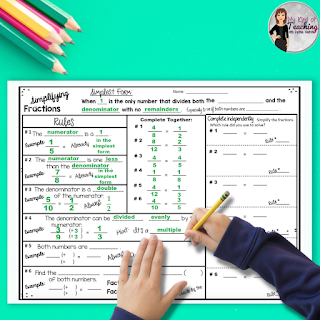Fractions Are Important
While there are many math concepts (especially higher-level ones) that make us think, "Can't we just skip this part? Why do we need to learn this anyway? We are never going to use it." This is NOT the case for fractions.
We use fractions daily without even realizing it. Dividing up a project among different people, cooking a meal, and cutting up that delicious pie all force us to apply our previously learned fraction skills.
Learning fractions is a foundational math skill that students need to be successful in everyday life. Let's look at a few other areas where focusing on fractions is important:
- Architects need precise measurements to plan structures
- Doctors need specific calculations for treatments and surgeries
- Contractors deal with fractions daily when building houses and businesses
- Moms cut up pizzas to serve their families
- And who can forget those 1/2 off sales
Fractions are the foundation of so many things. As teachers, we need to take the time to make sure our students really understand the concept. Getting them interested and excited about the topic by making it relatable can be a real game-changer.
How to Teach Fractions Effectively to Your Students
It's no secret teaching fractions can be tricky. This is because of their complex nature and a general lack of interest from students. Through lots of trial and error over the years, I've learned a few strategies that seem to work the best when focusing on fractions.
- Hands-on Learning - Making fractions visual to our students is a huge part of the learning process. Breaking out manipulatives and blocks allow students to build their own fractions. They can see and touch a fraction in a way that just looking at a picture doesn't quite meet. They can also gain a solid understanding of part, part, whole during this process.
- Visual Representation - It is important to see a fraction in several different ways. Having them create fractions on paper allows you to achieve this easily. You can use a grid to do this. Circle and pie graphs also work well for this activity.
- Technology - It's always good to mix it up a little and add some technology to our lessons. This makes the skill interactive and gives our students hands-on practice in a different way.
- Flexibility - Get ready to be flexible with your plans. It may take a little bit longer for your students to pick up on the concept than you'd hoped. That's okay. Take the time to go back and pull out the manipulatives again, or do what you need to reinforce the skill.

Most importantly, don't forget your patience! It will go a long way when teaching this skill.
Focusing on Fractions Activities
After the initial fraction introduction, it's time to break things down even further. I like to do that by focusing on three main categories and following a very strategic plan of action.
Simplifying Fractions
We all know that we must reduce a fraction to its simplest form. So, this is the next thing I introduce to my students after they have general knowledge of a fraction and its parts.
I do this by using a PowerPoint lesson and a companion worksheet. This strategy works well for me in all areas of teaching fractions. It's very methodical. My kids know exactly what to expect and enjoy the step-by-step process.
We begin with the PowerPoint lesson discussing what it means for a fraction to be in the simplest form. Then, we move into different ways to simplify fractions.
The step-by-step process forces students to ask themselves questions to determine if the fraction is already in simplest form or if it needs to be reduced.
Then it guides them through the process of doing just that. At the end of the presentation, there is an opportunity for some guided practice. I love this part of the lesson because I can see who "gets it" and who needs more practice.
The companion worksheet is a great addition to the PowerPoint presentation. I use them together. The beauty of it is that it allows for guided practice with amazing discussion opportunities, partner work, and finally independent practice.
As we work through the PowerPoint slides, we fill out the companion worksheet together. Be sure to take your time and work slowly through the powerPoint. This will give your students time to really think about their answers and allow them to gain a more in-depth understanding of the topic. My students always have a huge success rate with this process.
Improper Fractions
Now it's time to blow their minds! The very sight of an improper fraction or a mixed number will get your student's heads spinning. This concept does not look like the "normal" fraction you just spent so much time introducing. No worries! With a little time and a few steps, your students will be masters of improper fractions.

It's time to break out that PowerPoint lesson and companion worksheet. The slides discuss numerators, denominators, whole numbers, and how they relate to each other.
Most importantly, I reinforce the fact that improper fractions are NOT BAD just because they are different.
Remember to take your time when moving through the PowerPoint so your students can effectively complete the companion worksheet.
 I love it because the multiple pages and activities provide a chance for guided practice before throwing in the deep end on their own.
I love it because the multiple pages and activities provide a chance for guided practice before throwing in the deep end on their own. We complete the first page together as a group. It is an awesome sheet that's pretty much an interactive reference sheet. It reinforces the process and serves as a great guide for an independent practice where students will practice changing improper fractions to mixed numbers. Then they will simply the fractions if needed.
Students love how the process is broken down for them, and the tech aspect of it makes it fun! The PowerPoint is also great for reinforcing skills in small group instruction and intervention groups.
Decomposing Fractions
This lesson teaches students how to break apart fractions and see them in different ways. I like to demonstrate this with fraction models. I'm always game for a good old-fashioned hands-on lesson. If you have a class set, it's a great idea to allow students the opportunity to decompose fractions with their own blocks.
I use my tried and true PowerPoint lesson and companion worksheet here, too.
The slides take them through decomposing a fraction and a mixed number. Then it gives them the chance to work with a partner while decomposing numbers using pictures.
Of course, the companion worksheet is broken down to follow the PowerPoint exactly so your students will be able to follow along while staying actively engaged in the lesson.
Focusing on Fractions Just Got Easier
You can grab all of these lessons and practice activities in my Fractions Bundle. It provides a step by step process for teaching your students about:
The PowerPoint presentation walks them through the process while teaching them all of the rules along the way. They'll get hands-on practice of their own while completing the companion worksheet that goes with the activity. Grab this fractions bundle in my Teachers Pay Teachers store.
Save It For Later
Be sure to save all of this info for focusing on fractions to your favorite math board.
Helping you to make fractions easier for you and your students. That's just...
My Kind of Teaching!










This is a life saving blog! Fractions are the hardest thing to teach. We do not teach mixed fractions in 3rd grade but I love that you included it. This will help with extension.
ReplyDeleteThank you. I hope these REALLY help you!
ReplyDelete